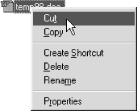Chapter 4. Context Menu Handlers
| only for RuBoard - do not distribute or recompile |
Chapter 4. Context Menu Handlers
The shell displays a context menu for a file object when it is clicked with the right mouse button. This context menu allows various operations to be performed on the file object from within the shell, like printing it or opening it with another program. For example, Figure 4.1 shows the context menu that's displayed when the user clicks on a file in Windows Explorer.
Figure 4.1. A context menu

The items on context menus fall into two categories: static and dynamic . Static context menu items are always the same for every file object of a given type. They can be associated with a file object with just a few registry entries and require no shell extension handlers. The "handler" in this circumstancethat is, the object that performs some action on the file object when that particular context menu item is selectedis usually a normal executable that is passed the name of the file as a command-line parameter. Dynamic context menus, on the other hand, are created with the help of a shell extension handler, which, as we discussed earlier, is a COM component that runs in-process to Explorer. This handler provides the means to display different context menu items for file objects of the same type. The exact appearance of the context menu typically is determined by some state internal to the file itself. Static menus warrant a brief discussion, but the main focus of this chapter will be on dynamic context menus.
| only for RuBoard - do not distribute or recompile |
EAN: N/A
Pages: 128